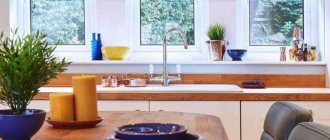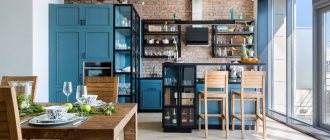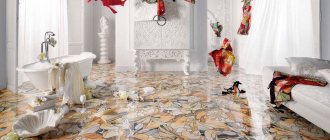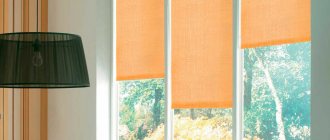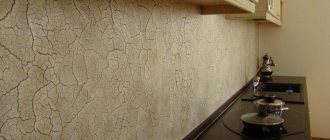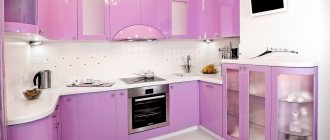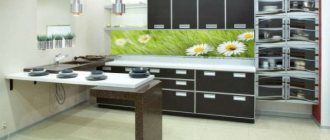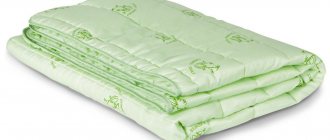The kitchen floor sets the stage for design and functionality. Consider your lifestyle and cost when choosing the right surface for you, as the kitchen is the center of your home, where you prepare family meals and gather together. Floors in this busy area must withstand heavy traffic, dropped dishes and spills. Start with these considerations.
The kitchen floor as it is
Let's not discuss the entire gender pie. Let's consider the top layer - composition, decor and features. The kitchen is the most “populated” part of the house (or apartment). Most of the family often tramples, cooks, washes, chops, and gets underfoot on this site. Therefore, the load on the floor passage is high.
We’ll also constantly add something falling, dripping, or splashing onto the long-suffering surface. So choosing a banal gender turns into a task with many unknowns.
Cork covering
Natural cork has many positive qualities. She:
- Eco-friendly;
- Pleasant to the touch;
- Maintains optimal temperature regardless of the ambient air condition;
- Not afraid of water, shock, insects.
Mold does not form under it, and the springy material is perfect for people with bad backs and children who constantly fall.
The disadvantage will be the high price of the material.
Wooden board, solid
How often our mothers were upset when they looked at the freshly washed plank floor: the paint didn’t stick and the floorboards were dry and not fashionable. Isn't it fashionable? A modern massive deck board with a finished coating is a luxurious floor, but not a budget one.
This type of floor also doesn’t like it when anything sharp or heavy falls on it: it leaves scratches that cannot always be healed.
Recommendations for color combinations
So, how to choose the color of the kitchen, taking into account the proportions? Here are a few rules that professional designers use.
- 60/30/10. These are the proportions of the ideal combination of the main tone and companions. Let's say you've decided what color to paint the walls in the kitchen. It takes up 60% of the entire design. The second companion, for example, the color of the ceiling and floor, takes up 30% of the gamut. In the third shade, individual furniture and accessories are made, and 10% is allocated to it.
- Color wheel. To understand what color of walls, ceiling and floor to choose for the kitchen, use the design circle. The picture shows the main combinations of different shades.
Linoleum in the kitchen
Linoleum, my beloved linoleum! It’s not a complicated hairstyle that a weak woman can handle on her own. Smooth surface that is so easy to clean. And black stripes from the soles, alas, even of house slippers.
When choosing, you need to take into account the density and wear resistance of various types of linoleum: for the kitchen, a wear resistance close to the industrial class is suitable.
But glass falling on such a soft and warm floor will not break!
How to choose the color of the countertop to match the kitchen set?
The color of the countertop for the kitchen set is in a neutral color: white, black, beige, gray, wood
A white kitchen set will suit a neutral countertop, imitating stone or wood . For a white kitchen, a cold stone color is preferable: black or gray. If it is an imitation of wood, then let it be light. Dark wood will put pressure on a white kitchen, and it will lose a significant share of its elegance.
On the contrary, it is better to complement a beige kitchen set with a dark wood or chocolate - it will set off the facades, making their creamy shade even more delicate and “sweet”. Mirror scheme: brown fronts - beige top.
A white and beige kitchen can be complemented with a countertop, the color of which is almost identical to the facades. This move will preserve the visual lightness of the light kitchen, its “fragility” and “weightlessness”. One of the features of such a composition will be femininity.
A dark countertop, on the contrary, will make a light monochromatic kitchen more brutal. It will emphasize the purity of the color of the facades, adding a contrasting effect to the set. A cream or beige kitchen, as already mentioned, can be complemented with a dark wood-colored countertop, and the best partner for a white set will be a black countertop.
A black countertop in a white kitchen is a luxurious option that has many admirers. This kitchen furniture looks elegant and, of course, expensive.
Another secret will help you decide on the color of the countertop for a white and beige kitchen set: you need to take into account the “apron” of the work area. If everything is light - the facades, the apron, and the tabletop, the overall picture will turn out “blurry”: the elements will merge and lose the clarity of shapes and lines. If you want a light countertop, make the apron, if not a contrast to the kitchen, then at least stand out against its background. If the apron is already decorated in light colors, complement the kitchen set with a contrasting countertop.
It is not advisable to pair a black kitchen set with a black countertop - the furniture will turn out too dark and gloomy for the kitchen. If you like this combination, make the apron light. Otherwise, as in the case of a light kitchen, everything will merge into a single spot.
A black kitchen and white countertops are a win-win solution. It is just as luxurious and elegant as the opposite option (white fronts - black top).
In addition, a black kitchen set can be complemented with a countertop that imitates the color and pattern of light wood (will add warmth and comfort to the black kitchen) or gray stone (will add visual high value).
Kitchens with gray facades are equipped with countertops in white, gray (a couple of shades darker or lighter than the facades) and black . Marble and other stone tops in achromatic tones look great.
For a kitchen with wood-colored facades, white, cream and wood-colored - the same or different in several tones. A combination with a black countertop is possible, but it is more risky. Expensive solid wood furniture can be equipped with a stone countertop with the appropriate color and pattern.
Another option for neutral and conditionally neutral kitchens is colored countertops . Yes, the solution is unusual, but extremely effective. The ideal basis for a colored top is a kitchen with white facades. An accent tabletop adds brightness and cheerfulness to a light interior. Where can I find a colored countertop? Look in the catalogs of manufacturers of laminated “tables” or place an individual order for a top made of acrylic stone, which can be given any color at the request of the customer.
Laminate in the kitchen
So beautiful, sleek and comfortable, but not in the kitchen. It does not like water and when washed it begins to swell and swell at the edges. But installation is reminiscent of laying out puzzles and brings no less pleasure.
The main thing to remember is that in a damp room and with frequent washing (and there is no escape from this), replacement will be needed early: usually after five years.
Kitchen floor tiles
It seems that tiles are the ideal covering for a kitchen floor: they look elegant and are easy to clean. But! If the apartment or kitchen in the house is located on the ground floor, and there is an unheated basement below, then in winter the floor will be too cold.
Note!
- Kitchen floor tiles: pros and cons of tile flooring. The best kitchen design ideas with photo reviews
Laminate for the kitchen: TOP-130 photos of coating ideas, pros and cons of laminate. Choosing kitchen floor colors
- Linoleum for the kitchen - master classes on installing linoleum in the kitchen interior. The best design ideas and color schemes (120 photos)
The tile requires professional installation and does not like heavy objects falling from a height. And glass objects don’t like to fall on the tiles; the chances of survival are zero.
Unsuitable coatings
There are quite a lot of floor design options, and choosing the most suitable covering is quite difficult. But we can safely recommend walking proudly past the carpet.
This material:
- Gets dirty quickly;
- Requires complex care;
- Flammable
Parquet and parquet boards, which do not tolerate changes in humidity and temperature changes, will not feel very good.
If you still want to decorate the kitchen as gently and beautifully as possible, then these sensitive materials are transferred to the dining area.
Criterias of choice
The choice of flooring for the kitchen depends primarily on the owners’ (more precisely, the hostess’s) own preferences and taste, but in addition to the design, it is important to take into account the technology and features of the building itself. For example, take into account the maximum possible load in ancient houses with wooden floors. But at the same time, we can highlight general recommendations for selection:
If the family is not large and there are no small children or pets in the apartment, then the floor with any coating will last a long time.
If there are children, cats and dogs in the house, and in the kitchen something often spills or falls on the floor, it is better to choose tiles or porcelain stoneware, but always with a non-slippery surface.
If the kitchen area is up to 10 m2, it is advisable to make the flooring from one material and not split the space.
If the room combines a kitchen and a living room or dining room, several types of flooring are used simultaneously: tiles and laminate, parquet and porcelain stoneware, the main thing is not to overdo it and not get the effect of a “flooring store.”
When choosing between wood and tiles, it is not necessary to sacrifice aesthetics in the name of practicality: tiles and porcelain tiles are produced that imitate parquet blocks, including those with an aging effect.
Think over and take into account the features of your kitchen flooring in advance, and it will last for many years without requiring expensive repairs.
Color of the floor, ceiling and walls - modeling the space
It's no secret that with the help of flowers you can transform and change the perception of space beyond recognition. Depending on your goals, choose the option that will highlight the advantages of the room and hide the shortcomings.
The effect of combining different colors:
- the light color of the floor, walls and ceilings will make the room flowing and spacious, the main thing is not to overdo it, otherwise you can end up with a pale and cold room. One of the walls covered with bright wallpaper will help break the monotony;
- dark floors, light ceilings and pastel-colored walls also give the effect of expanded space, but without impersonality;
- a light floor and ceiling, dark walls horizontally stretch the room, making it lower. This effect is especially pronounced when there is a large window or one light wall;
- the dark shade of the floors and walls combined with the white ceiling creates a basement effect.
Obviously, neither a basement nor a white infinity is desirable for any room, especially in the kitchen and bedroom. But an overly snow-white hall can be saved with the help of a dark, expressive plinth and doors, for example, by lowering it from heaven to earth.
